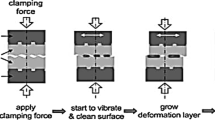Abstract
Ultrasonic welding is a subset of frictional solid-state joining processes. This process, with its ability to join thin and dissimilar metallic materials, has been noticed by researchers. On the other hand, the dissimilar joining of aluminum and copper wires and electrodes in the battery of electric cars and hybrid electric cars to reduce the cost and weight of the car structure has been raised as one of the important industrial challenges. Therefore, in this research, ultrasonic welding of dissimilar joining of Al 1050 sheet with a thickness of 0.2 mm and copper wire with a cross-sectional area of 2.5 mm2 was studied. For this purpose, the experiment was designed based on the response surface methodology (RSM) and Box-Behnken design (BBD). Static pressure, welding time, and vibration amplitude were selected as input variables in three levels. Then, the tensile test was performed on the specimens to evaluate the shear strength of the welded joint. The results of ANOVA showed that the linear and second-order effects of static pressure and vibration amplitude have the greatest effect on the shear force. Also, the regression model of shear force was extracted as a function of linear, interactive, and quadratic terms from the input variables. Finally, the optimal combination of input variables to achieve the maximum shear force was determined with a desirability of 0.935, and by performing the verification test, the competence of the regression model to predict the shear force was confirmed.













Similar content being viewed by others
Data Availability
The authors state that the data supporting the results of this research are available in the paper. Also, data sets created during the current study are available from the corresponding author upon reasonable request.
References
Matheny M P, Graff K F Ultrasonic welding of metals. Power Ultrason, Woodhead Publishing (2015) 259–293
Kumar S, Wu C S, Padhy G K, and Ding W, J Manuf Process 26 (2017) 295.
Watanabe T, Sakuyama H, and Yanagisawa A, J Mater Process Technol 209 (2009) 5475.
Zhao Y Y, Li D, and Zhang Y S, Sci Technol Weld Join 18 (2013) 354.
Shawn Lee S, Shao C, Hyung Kim T, Jack Hu S, Kannatey-Asibu E, Cai W, Patrick Spicer J, and Abell J A, J Manuf Sci Eng 136 (2014) 051019.
Chen K, and Zhang Y, Procedia Eng 81 (2014) 2117.
Haddadi F, Mater Design 66 (2015) 459.
Chen K, and Zhang Y, Mater Design 87 (2015) 393.
Komiyama K, Sasaki T, and Watanabe Y, J Mater Process Technol 229 (2016) 714.
Ni Z L, and Ye F X, Mater Manuf Process 31 (2016) 2091.
Matos S, Veloso F, Santos C, Gonçalves L, and Carvalho E, J Environ Sci Eng A 7 (2018) 125.
Gester A,Wagner G, Kesel I, Guenter F Mechanical and microstructural characterization of ultrasonic metal welded large cross section aluminum wire/copper terminal jointsLight Metals, The Minerals, Metals & Materials Series, Springer, Cham, (2019) 1491–1498
Abdi Behnagh R, Esmaeilzadeh P, and Agha Mohammad Pour M, ADMT J 13 (2020) 23.
Ma Q, Song C, Zhou J, Zhang L, and Ji H, Mater Sci Eng A 823 (2021) 141724
Singh A R, Sudarsan C, Das A, Hazra S, and Panda S K, J Mater Eng Perf 31 (2022) 4133–4149.
Silva R G N, De Meester S, Faes K, and De Waele W, J Manuf Mater Process 6 (2022) 1.
Pöthig P, Grätzel M, and Bergmann J P, Weld World 67 (2023) 1427.
Khuri A I, Cornell J A, in Response Surfaces: Designs and Analyses, (2nd ed) CRC Press (1996)
Lapian F E P, Ramli M I, Pasra M, and Arsyad A, Appl Sci 11 (2021) 1.
www.minitab.com, accessed 3 August 2022.
www.iranultrasonic.ir, accessed 3 August 2022.
www.inso.gov.ir, accessed 3 August 2022.
www.iec.c, accessed 3 August 2022.
www.matweb.com, accessed 3 August 2022.
Montgomery D C, Design and Analysis of Experiments, 3rd edn. Wiley, New York (1991).
Myers R H, Montgomery D C, and Anderson-Cook C M, Response Surface Methodology: Process and Product Optimization Using Designed Experiments, 3rd edn., Wiley, New York (2009), pp 96–85.
Acknowledgements
The authors express their gratitude and appreciation for the support of the management and personnel of Iranultrasonic Company. This work was supported by the Iran National Science Foundation (INSF) [Grant Number 99022838].
Author information
Authors and Affiliations
Corresponding author
Ethics declarations
Conflict of interest
The authors declare that they do not have any conflicts of interest to report about the current study. The authors state that they do not have any financial conflicts of interest or personal relationships that may have affected their work.
Additional information
Publisher's Note
Springer Nature remains neutral with regard to jurisdictional claims in published maps and institutional affiliations.
Rights and permissions
Springer Nature or its licensor (e.g. a society or other partner) holds exclusive rights to this article under a publishing agreement with the author(s) or other rightsholder(s); author self-archiving of the accepted manuscript version of this article is solely governed by the terms of such publishing agreement and applicable law.
About this article
Cite this article
Jarahi, F., Vahdati, M. & Abedini, R. Modeling and Optimization of Shear Strength of the Welded Joint Produced by Ultrasonic Welding of Copper Wire to Aluminum Sheet. Trans Indian Inst Met (2024). https://doi.org/10.1007/s12666-024-03336-6
Received:
Accepted:
Published:
DOI: https://doi.org/10.1007/s12666-024-03336-6




